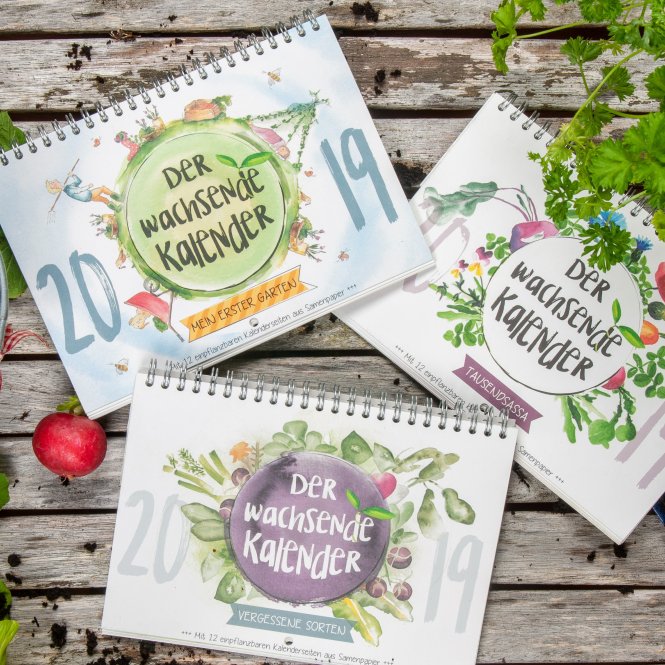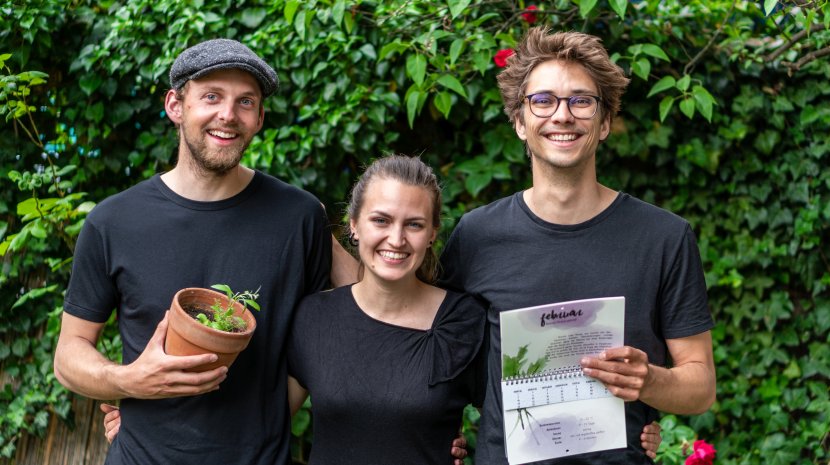

From the EUR 5 business competition to products that make the world a little better: The winner of the Best New Product Award at BIOFACH 2019, the "Growing Calendar" inspires gardening - even in the city - and tells of old varieties and biodiversity.
In the beginning, there was the desire for meaningful self-employment of three students. The competition was quickly followed by the founding of the company. Today - a little more than a year later - the young start-up Primoza from Nuremberg is growing and thriving. Its goal is to use the Growing Calendar to bring people - from small to large - closer to nature and to the topics of biodiversity and urban gardening. Further inspiring products have long been in the pipeline and at BIOFACH Manu, Tobi and Orlando were among the beaming winners of the Best New Product Awards 2019, representing a growing team.

The beaming winners of the Best New Product Awards 2019 (from left to right): Tobi, Manu and Orlando from primoza GmbH in Nuremberg.
We spoke to Orlando Zaddach, one of the three founders, about how it all began, what motivates them as young entrepreneurs and what fans of the Growing Calendar can look forward to in the future.
First of all, congratulations on winning the Best New Product Award at BIOFACH 2019 for the Growing Calendar! First of all, would you like to tell us how it all started?
Even before we registered for the competition at the University of Erlangen-Nuremberg, the three of us were toying with the idea of starting our own business. That was in the winter of 2017. The idea of a plantable wall calendar was then born quite quickly one afternoon. So making something with seed paper, combined with information on when to plant what. A bit more complicated was the question of how to get the seed paper and calendar sheets together, and which seeds would be particularly suitable for the calendar. Bit by bit we developed the calendar with spiral binding and the different variations.
In a very practical way - in a nutshell "for the show with the mouse" so to speak! - How do the seeds get into the paper and how does it become a calendar?
The seed paper consists of two layers of paper, with the seeds in between. The days of the month are printed on the seed strips and the whole thing is bound together with monthly sheets. Finished is the growing calendar. At the end of the month, the seed strip can be torn out and planted.
Who is behind the growing calendar? And how did you finance your project?
Primarily we three founders, Manu, Tobi and me. However, we also got a lot of support from our friends and family members! We financed our project idea through a crowdfunding campaign.
In the run-up to BIOFACH 2019, you described your calendar with three hashtags, what do they mean to you or what do you associate with the terms?
Our calendars are produced regionally and in an environmentally friendly way and also create long-term added value beyond the year.
Our calendars are dedicated to the preservation of biodiversity. The "Forgotten Varieties" calendar, for example, features flowers, herbs and vegetables that are rarely cultivated today. By the way, this was the fastest selling calendar, although it is also the most expensive due to the old and rare varieties! And: All of our calendars contain flowering plants that bees and other insects can enjoy.
All of our calendars include flowering plants for bees and other insects to enjoy.
We find: You don't need a garden for joyful and successful gardening! Even in the city there are many possibilities to create small green oases and to become active yourself. Our calendar "Jack of all trades" appeals to exactly those people who do not have a balcony or garden, as we use quite frugal seeds here. So you don't need much more than a window sill, a pot, some soil and water and you're ready to go.
Cue urban gardening - for all gardeners: What story does the calendar page for May tell us or what are we sowing?
In May we will sow the carrot Gniff (Forgotten Varieties). This is an unusual purple beet from the Swiss canton of Ticino. The characteristic colour is due to pigments called anthocyanins, which are said to improve heart health and have anti-cancer effects. Such a carrot also contains even more beta-carotene than its orange relative, which not only has a positive effect on eyesight, but also - eaten by cows - turns milk pink ...
In addition to the "Forgotten Varieties" and "Jack of all trades" calendars, there is also a calendar especially for children...
Yes, we want to invite children and of course their parents to playfully deal with the topics of species and variety diversity, sustainability and urban gardening via the calendar "My first garden" - and bring them closer to nature again! In addition to seed paper and information, this calendar also includes activities such as how to build a teepee together....
At BIOFACH 2019, the Growing Calendar won the Best New Product Award! What was BIOFACH like for you?
A totally beautiful and exciting experience! For the three of us it was the first trade fair and then such a big one. We were also particularly pleased about all the positive feedback from the trade fair visitors. The Best New Product Award was the crowning glory.
What will happen now? Are there already new ideas?
The Growing Calendar will be back again next year! We don't yet want to reveal exactly which variants we will be offering. Only this much: We have been working feverishly for weeks on a new variant that can also be used beyond one year and differs strongly from the others in terms of content. Since all of us in the team are passionate about cooking, there will soon be a cookbook with bound seed paper! That way you sow and harvest the ingredients for the delicious dishes yourself!
What is particularly important to you in all of this?
Basically, we want our products to make the world a little better - or at least not worse - and to sensitize people to issues such as biodiversity and environmental protection!
Mr. Zaddach, thank you very much for the interview - we are looking forward to seeing what else you develop together and would be delighted to meet you again at the next BIOFACH!
Image credits:
primoza GmbH



